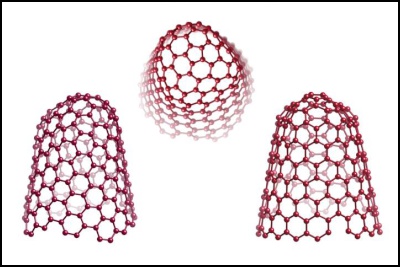NEC begins marketing "Carbon Nanohorn"
NEC News Release
NEC
begins marketing “Carbon Nanohorn”
– Wide ranging uses include
medical innovations and capacitor enhancement
–
Tokyo, January 29, 2013 – NEC Corporation (NEC; TSE: 6701) announced today the availability of the “carbon nanohorn,” a form of carbon nanotube (*1), that can be used for a wide range of purposes, including medical innovations and capacitor enhancement.
Carbon nanohorns were first discovered in 1998 by a research team lead by Dr. Sumio Iijima, Senior Research Fellow, NEC Corporation. Each carbon nanohorn is approximately 2-5 nm (nanometers) in diameter and 40-50 nm long (figure: 1). When several thousand are collected together, carbon nanohorns or carbon nanohorn aggregates can form a spherical shape that is approximately 100 nm in diameter with a wide surface area per unit mass. This formation boasts a range of unique characteristics that include easy dispersion and high conductivity.
Carbon nanohorns are expected to be used with materials spanning industries throughout the world, including the medical field (e.g. as a carrier for drug delivery systems), the electrical component field (e.g. capacitors, actuators and fuel cells) and others.
“NEC is initiating these sales activities following the development and successful testing of technologies and equipment that can mass produce 1kg of 95% pure carbon nanohorns each day,” said Masayuki Hasegawa, assistant general manager, NEC. “We are now approaching businesses, universities, research centers and others in order to promote the sale and co-development of applications using carbon nanohorns. NEC aims to provide these materials to 20 organizations within the next 3 years.”
Key features of carbon nanohorns include the following:
1) Unique
structure and properties that enable its adoption for a wide
range of purposes
• Approximately
2-5nm in diameter and 40-50nm in length. Several thousand
can be gathered together in order to form a spherical shape
of approximately 100nm in diameter.
•
Wide surface area per unit mass. Surface area expands by
approximately 5 times when carbon nanohorns with holes
(holey carbon nanohorns) are formed by oxidation
treatments.
• The wide surface area
and high electrical conductivity of carbon nanohorns enable
capacitors to carry a larger capacity and actuators to
provide stronger propulsion. Furthermore, their adoption
with fuel cells enables greater output.
•
Carbon nanohorns are being used in research to treat cancer
as “carriers” for “drug delivery systems” that can
administer drugs directly to affected areas.
•
Resistant to fusion with other materials, making them well
suited for encapsulating highly reactive gas and other
sensitive substances.
2) High
expectations as a “carrier” for medications due to their
lack of metallic impurities and spherical configuration
• Carbon nanohorns are free from
metallic impurities since metal catalysts are not used in
their creation process. Moreover, a variety of tests carried
out on cells and in vivo have detected no short-term
toxicity.
• High expectations are
placed on carbon nanohorns as a safe “carrier” for
medications since their 100nm spherical structure has no
negative impact on surrounding cells and tissues.
3) Low cost
• Since
carbon nanohorns can be efficiently produced using simple
methods (Pulsed Laser Ablation Method, *2) at room
temperature and under normal atmospheric conditions, they
can be provided at a low cost when compared to the cost of
other nano carbon materials that are complicated to produce.
• Carbon nanohorns can be mass
produced at more than 1kg each day using NEC technologies
and equipment in order to quickly meet the needs of
business.
Going forward, NEC will actively
promote the use of carbon nanohorns as part of contributing
to the advancement of electronics, medical technologies and
businesses throughout the world.
NEC will showcase these materials at the Nanotechnology Business Creation Initiative booth at “nano tech 2013,” at Tokyo Big Sight from 30 January to 1 February 2013.
###
Notes:
(*1) Carbon nanotube:
Carbon nanotubes are
a carbon material first discovered by Sumio Iijima in 1991.
They have a cylindrical carbon atom structure and are
approximately the size (diameter) of 5 – 10 atoms.
(*2) Pulsed Laser Ablation Method
This is a method
for producing carbon nanohorns where a graphite target (mass
of carbon) is irradiated with a strong CO2 laser. This makes
it possible to easily produce high-purity carbon nanohorns
at room temperature.
See figure: 1 – CNH_3.bmp file attached.

About Carbon nanohorns
http://www.nec.com/en/global/prod/cnh/
.
________________________________________
About
NEC Corporation
NEC Corporation is a leader in
the integration of IT and network technologies that benefit
businesses and people around the world. By providing a
combination of products and solutions that cross utilize the
company’s experience and global resources, NEC’s
advanced technologies meet the complex and ever-changing
needs of its customers. NEC brings more than 100 years of
expertise in technological innovation to empower people,
businesses and society. For more information, visit NEC at
http://www.nec.com .
ENDS


 Mānuka Charitable Trust: Mānuka Charitable Trust Warns Global Buyers Of Misleading Australian Honey Claims
Mānuka Charitable Trust: Mānuka Charitable Trust Warns Global Buyers Of Misleading Australian Honey Claims  Engineering New Zealand: NZ Building System Needs Urgent Improvement
Engineering New Zealand: NZ Building System Needs Urgent Improvement GNS Science: Bioshields Could Help Slow Tsunami Flow
GNS Science: Bioshields Could Help Slow Tsunami Flow Transport and Infrastructure Committee: Inquiry Into Ports And The Maritime Sector Opened
Transport and Infrastructure Committee: Inquiry Into Ports And The Maritime Sector Opened Netsafe: Netsafe And Chorus Power Up Online Safety For Older Adults
Netsafe: Netsafe And Chorus Power Up Online Safety For Older Adults RBNZ: 10 Cent Coin With King Charles III Image Now In Production
RBNZ: 10 Cent Coin With King Charles III Image Now In Production


